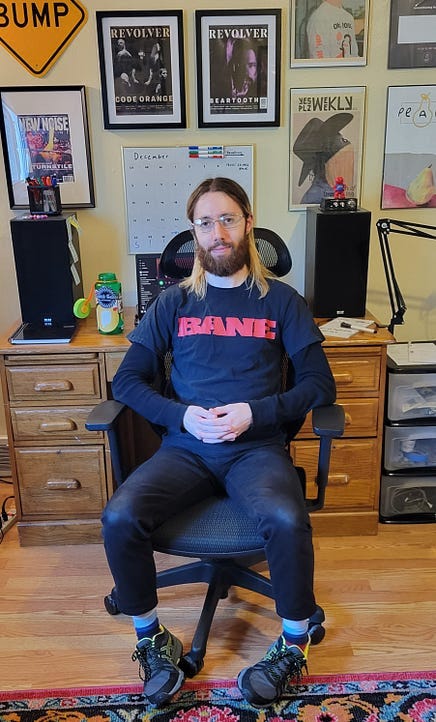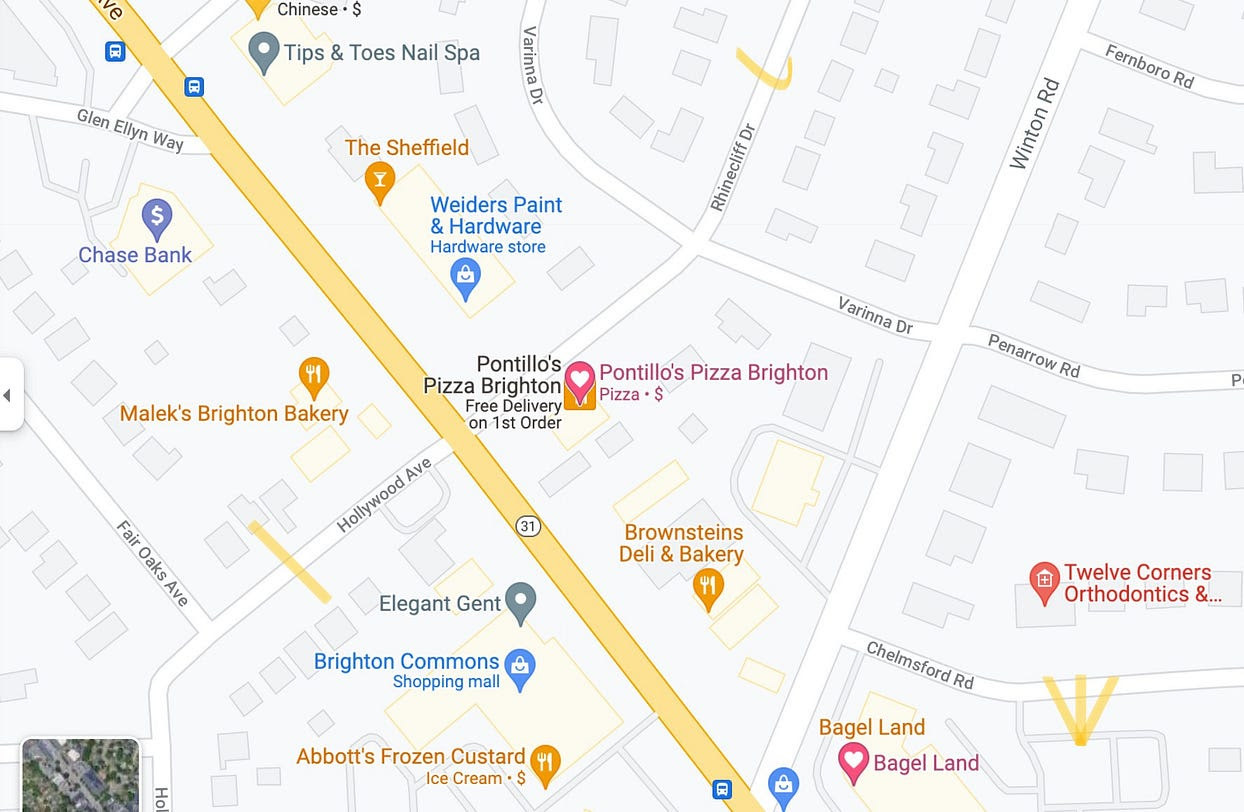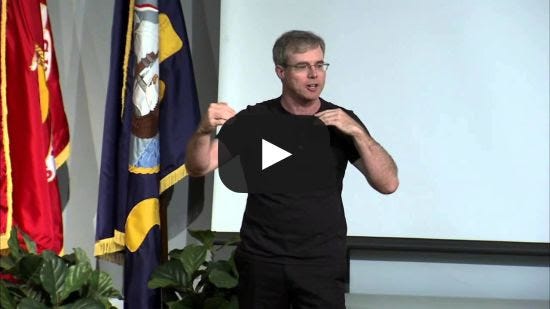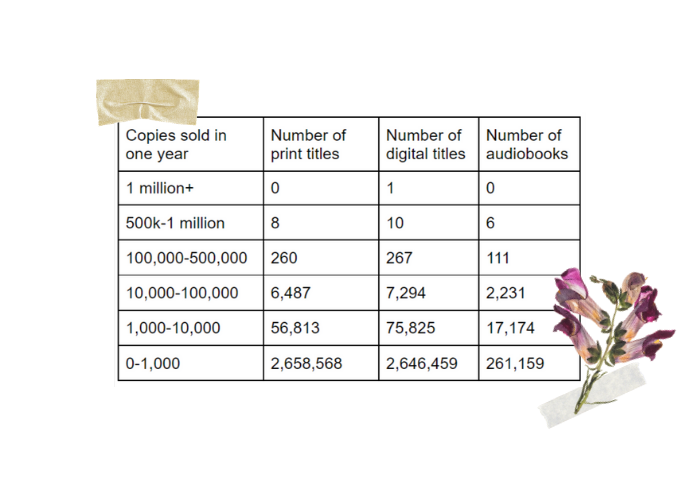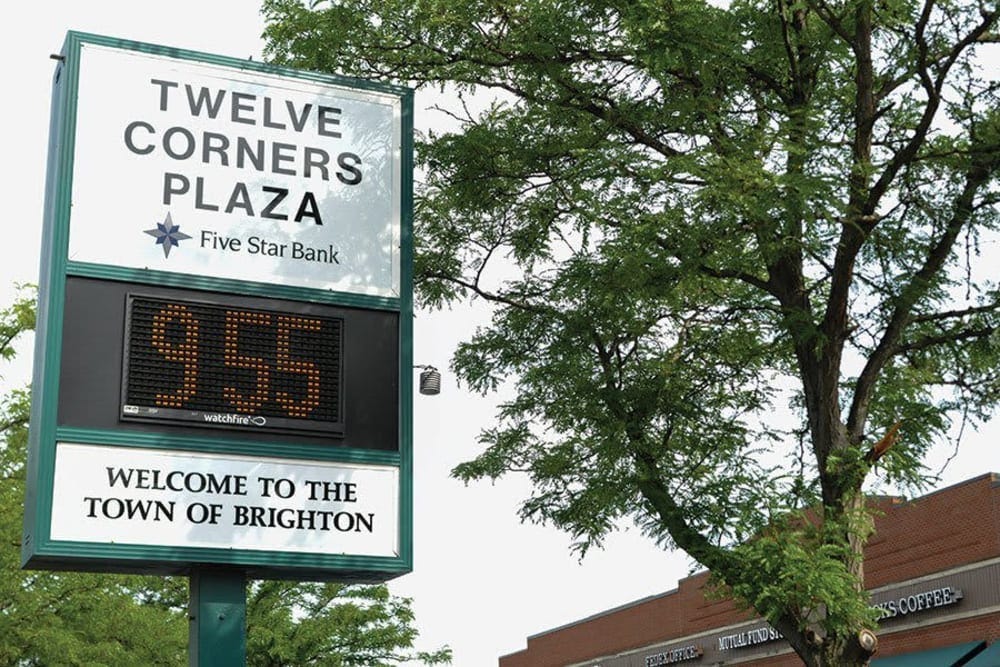Shuffle Synchronicities: Volume 1 - #333
Guest Post by Eli Enis (Endless Scroll) + "Pintar el Sol" by Chancha Vía Circuito - 12/16/21
I’m introducing what Substack calls a ‘discussion thread', which are meant to encourage community.
The first discussion thread is inspired by a paid subscriber reader who recently told me she’s started to notice music synchronicities in her own life.
So it made me think to ask:
Have you had any music synchronicities recently?
To quote Yusuf / Cat Stevens:
“Don’t Be Shy”
Lastly, I’ll also mention that from now until we get to 365 daily posts, which should be just over a month from now, I’m offering a 50% discount on paid subscriptions.
What do you get for a paid subscription?
Honestly, not anything more than you’re already getting.
I’ve tried paid album posts and offering copies of a future book.
But ultimately I keep coming back to the belief in the gift economy model for art.
Which relies on patronage and donation (as well as me working another job so as not to compromise for the commercial market) all to keep all of the content free for anyone who wants to read it.
That said, it would be great to add some new paid Subscribers.
What will that do?
It’s actually kind of really important.
Primarily, it’ll help other readers discover Shuffle Synchronicities because Substack ranks its newsletters by paid subscriber numbers and income generation.
Secondarily, it’ll help me to continue to pay guest posters a small fee for their contributions (like today’s!)
And yeah it might help me live a little :)
Additionally
I am indeed in the process of putting together a book after all.
Like books of Selected Verses or Selected Poems or Selected Stories, it’s going to be called:
Shuffle Synchronicities: Selected Posts from the Substack
And it’ll contain some of my, and hopefully your, favorite posts from the year.
Feel free to leave a comment if a post, in particular, comes to mind.
One more thing
5 of my top 20 email open rates have come in the past month, all around or over 50%. The industry average is somewhere around 15-25%.
So thank you!
And, yeah, here’s that paid subscriber discount button again!
OK, the guest post!
I met today’s guest poster, Eli Enis, after I read his Substack Endless Scroll’s post about my favorite hyper-pop artists, 100 gecs, and their new song “mememe”.
“mememe” by 100 gecs
I had just attended a 100 gecs concert in LA, which I wrote about at the end of this post here, and Eli seemed to capture what it was like for people of his gen z generation to rally around the hyper-pop movement, which I am relatively aged for.
Here’s a more formal bio!
Eli Enis is a Pittsburgh-based music journalist who's currently an editor at Revolver Magazine and a co-host of Endless Scroll, a podcast about music, the internet and where they intersect. He's previously written for Rolling Stone, Billboard, Entertainment Weekly, Stereogum, Vice, etc., and has strong opinions on seltzer.
If you liked what he wrote here, you can find more of his personal blog writing at endlessscroll.substack.com and hear his voice every week on the podcast, where he talks about contemporary indie-rock, emo, punk, pop, and more with his three lovely co-hosts. Endless Scroll also has a Patreon where you can subscribe for an extra episode each week, as well as bonus editions of the newsletter, special shoutouts and more.
Without further adieu, take it away, Eli!
“Phone Calls at 3 AM” by Equipment
This is a song by an indie-emo band from Ohio that I was head-over-heels in love with when it came out in fall 2016. I was a senior in college and my main writing gig was for a punk-focused music blog called The Alternative, where I was an editor and a consistent contributor. Back then, my favorite genre of music was indie-rock that was stricken with malaise and fueled by half-drunken, half-depressed, half-desperately creative impulse. Slacker rock, lo-fi bedroom pop, and emo bands who were more influenced by early Weezer than American Football. Equipment's EP, Chump, existed somewhere in the middle of that venn diagram, and at the time I thought they were a really cool band with a ton of promise. I remember being hip to them pretty early, when they were basically just a local band who had connections to other bands and scene peeps I knew on the east coast DIY circuit. I remember writing about this project in a list of my favorite EP's of the year, and if I recall correctly, this was the song that indicated to me that they could make something more nuanced than just a straight-forward, snappy indie-pop track. This was their "reach" song.
I'm writing this from a place of remove because it really feels like so long ago that this was the type of music I was ravenously consuming. My taste has changed considerably since then, and now if I heard this song I probably wouldn't think much of it other than, "Hm, definitely doing a Brand New thing here." When this song came out, "doing a Brand New thing" was a description a band could be proud of being slapped with, so if my wistful, nostalgic reflection doesn't drive home the chronological distance here, then that little nugget certainly will. Anyways, the song isn't bad by any means. It's effective for what it is -- an anxious, 2 a.m. self-evaluation that finds the narrator staring into the mirror and giving himself the type of brutal, ass-kicking pep-talk that sounds like it's working in the moment but is simply too imposing to follow through with the next morning. We've all been there, I imagine, and I was certainly there on a near-weekly basis when I was freshly 22 and half-heartedly letting myself rot from hedonism while my left pulmonary arteries yearned for some semblance of sober clarity and routine.
"You're a mess, Nick / She's gone for 30 seconds and you're flying off the handle / You're the worst, Nick," the singer, whose name is Nick, intones with a concerned mutter. It's lip-gnashing self-hatred -- bloody, uncomfortably confrontational, suffocatingly harsh -- but the music is filled with quiet space that hangs like an awkward pause after a tremendous argument. For a couple minutes, it's all gradual build until the fuzz palm-mutes eventually come in, the voice goes full yelp and it's ragged Midwest emo with a predictably cathartic payoff. My 22-year-old ears probably celebrated the loudness with beer-cracking glee. My 27-year-old ears wish it never exploded into irritating yawps because then the tension never breaks. It ends with absolutely no sonic reward for the listener. But that would mean Nick would have to follow through with the discipline he's trying to convince himself he has during this moment of tumultuous panic. In that sense, I really relate to his songwriting decisions here because I would've done the same thing if I wrote this song in the era during which I discovered it. Now, I'd cut it a minute early because I have a better understanding of how life-altering process requires patience and only occasionally yields bursts of tangible reward.
So I guess what this song makes me feel, listening to it now in the laundry mat while I type this out in my Google Docs app, is personal growth. I like that a song that's so intensely wrapped up in the drama of being an adolescent can make me reckon with my own maturity. Thanks, Nick. Hope you got it figured out, too.
Thanks so much, Eli!
Speaking of synchronicities, after yesterday’s post, where I described how the street I grew up on is also called Hollywood Ave, I read Eli’s latest post today on Endless Scroll, and discovered that he also grew up in Rochester, also in the town of Brighton!
He was on Chelmsford Road, which is basically a triangle with Malek’s and my parents’ street and his street, with of course about 10 years difference.
Here’s a version of almost the same map as yesterday with his street included this time.
As Eli said about it: “what a wild coincidence!”
Or is it???
✨✨✨
No wonder, like fellow Western New Yorker, George Saunders, who now also has a Substack, I relate so much to Eli’s work!
According to the After School Substack, which is about gen z, and Casey Lewis’ link to this Screen Shot article by Malavika Pradeep, it’s more unclear why I love the music from his generation:
The majority of us stop listening to new artists and their music by the time we turn 33… “There’s evidence that the brain’s ability to make subtle distinctions between different chords, rhythms and melodies gets worse with age,” Frank McAndrew, Professor of psychology at Knox College, wrote in a column for The Conversation. This is exactly why newer and less familiar songs might “sound the same” to older generations. The songs and artists that shaped their personal taste are completely different from the genres 2021 has been increasingly witnessing.
Nevertheless, it’s great to see the next generation is able to become aware of the benefits of ‘sober clarity’ and track their own personal growth between the ages of 22 and 27.
For me, there might have been none of that between 22 and 35.
But since the age of 35, I have been able to track a few things.
Besides sober clarity, one of them is my relationship to movies, TV, and books.
For instance, in the past, I would never have read a popular book of fiction.
Like Project Hail Mary by Andy Weir, the author of The Martian.
Let alone admitted to enjoying the adaptation of that movie.
But it was chosen by my sister’s husband-in-law for our sibling book group.
And I read it this week.
And absolutely loved it!
Honestly, I even teared up at a certain point.
The main character, Grace, refers to our Sun as ‘Sol’, which is what made me think of it in terms of today’s song:
“Pintar el Sol” by Chancha Vía Circuito
~Chancha Vía Circuito is the stage name of Pedro Canale, who is a producer, DJ/remixer and composer, from Greater Buenos Aires, Argentina.
Fusion of electronic music and cumbia is the key factor of Chancha Vía Circuito's music.
He explores the minimal side of digital cumbia with inspiration from Afro-dance, murgas, minimal dub, IDM, and downtempo.
Computer bleeps share sonic space with folkloric chant.
Candombe drums are accompanied by the sample of a machete splicing the air and a vocal line of indigenous bebop is layered over hints of dub.~
This other song might be my favorite of the few I’ve heard of his:
“Sueno en Paraguay” by Chancha Vía Circuito
Speaking of dreams…
A reader of this Substack also happened to recommend Andy Weir when she first read it because he is one of the most successful authors who started as a DIY self-publisher.
She sent over then this YouTube video and said she thought I had what it takes to follow in his footsteps.
However, I read two pretty clearly sober posts yesterday about the state of publishing by Elle Griffin of the Substack The Novelleist here and here.
In the first one, Elle mentions that:
“The New York Times caused a stir recently when, in an article about pandemic book sales, it disclosed that ‘98 percent of the books that publishers released in 2020 sold fewer than 5,000 copies’….and 96 percent of books sold less than 1,000 copies.”
She posted a chart breaking down the numbers further:
I would like to say now that I’ve actually been a number of times in that top 96% bucket of 56,813 print titles that sold 1,000 - 10,000 copies in one year with my Haggadahs.
But have also been in that 2,658,568 bucket of books with 0-1,000 copies sold with some of my more experimental work.
Ellie believes that subscription-based writing has the potential for more income for writers than traditional publishing and to that end, she’s serial publishing her new book, Obscurity, a gothic novel, for paying subscribers through June 2022.
Check out the first chapter here.
I’ve also re-noticed via reading her newsletter that Substack has made a big push into comics and graphic novels:
“On June 9th, Business Insider announced that Substack hired Nick Spencer, author of Captain America and The Amazing Spider Man franchises to entice comic-book writers to the platform. They also announced, in August, their first round of investments in comics writers.”
It’s given me the idea to potentially publish my ‘painted’ novel, We Bought a Gun, as a serial as well.
It’s interesting, we’re 70% done with the illustration, and we’re slated to reach 260 pages, which if you divide by 5 you get 52, which is the exact number of weeks in a year, which made me think I could divide up the book into weekly releases of 5 pages for a year, which when I looked at the pages so far actually works really well with the cadence of the story.
Would you guys be interested in reading a graphic novel in such a way?
For what it’s worth, Ellie actually wrote about Andy Weir’s success:
Andy Weir first published The Martian as a serial for his own blog, then as a self-published novel on Amazon, then as a traditionally published novel with Random House.
“I had an email list with about 3,000 people on it, so, initially, the audience was roughly that much,” he tells me. “When I first posted it to Amazon, I didn’t do anything to market or publicize it. All I did was tell my readers it was available there.”
The book was on Amazon for five months, at a price point of 99 cents, and he sold 35,000 copies before Random House bought the rights in February of 2014. The book went on to become a New York Times bestseller and a blockbuster movie starring Matt Damon.
“The publicity and marketing machine of a traditional publisher can’t be beat,” he says. “They get your book into the hands of reviewers who have a lot of influence. The only con is that they get the lion’s share of the sale price. But considering the bulk of that goes to paying for the creation of the physical book, I’m not too worried about it—and their marketing engine makes it more than worthwhile.”
When I tell this story to Barton, she says Weir’s story doesn’t prove that the traditional publishing model works best, only that traditional publishers are trying to find some guarantee that a book will have an audience—and 35,000 sales in five months, with no marketing, meant they had a sure thing on their hands.
“I’m not sure that any of the traditional publishing success for [Weir] would be possible without those first two steps,” she says. “In that particular case, we might be giving unfair credit to the traditional publisher piece of that career progression.”
In other words: there is no algorithm that suggests that books about scientists growing potatoes on Mars will be successful. Even Big Five publishing houses are unable to predict which books readers will love and which books they won’t. The only thing they can predict with any certainty is whether or not the author has enough followers that will purchase their book—and Weir had 3,000 devoted readers. It all started because of them.
“You have this dichotomy,” Deahl says of the publishing industry. “You’re always looking for people with really big platforms. If Kanye West is going to publish a book, he’s got a big audience already, you don’t have to build an audience for him. So someone with a built-in audience, who can reach out to them and say ‘I’m publishing a book,’ that book can become a bestselling book immediately.”
It’s a gamble. “You will always have daydreams about why this book and why not that book,” Deahl says. “You will always have more books failing than not.” But the one thing we know for sure is that devoted fans make all the difference. Because whether a book is traditionally published, self-published, or serialized, alone its odds of success are next-to-none—but with a couple thousand devoted fans, anything is possible.
In his final advice to me, Weir offers this: “I would say to try the traditional route first. If you can’t get traction with agents or publishers, then consider self-pubbing. If your book does well as a self-pubbed ebook, you can go back to agents and publishers and say ‘look, it’s a proven seller.’”
Guess I’ll get to work.
Guess I’ll continue to get to work, too ;)
And not in the “anxious, 2 a.m. self-evaluation that finds [me] staring into the mirror and giving [myself] the type of brutal, ass-kicking pep-talk that sounds like it's working in the moment but is simply too imposing to follow through with the next morning,” like Eli doesn’t recommend, but the kind Eli does advise: “how life-altering process requires patience and only occasionally yields bursts of tangible reward.”
I guess that’s another example of yesterday’s ‘The Brighton Way’.
Okay, that’s the three hundred and thirty-third Shuffle Synchronicities 🔀 ✍️ 🎶 ✨



